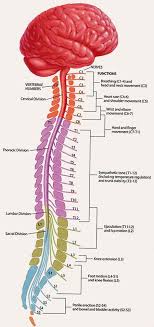
As many as 500 000 people suffer a spinal cord injury each year. People
with spinal cord injuries are two to five times more likely to die
prematurely, with worse survival rates in low- and middle-income
countries. The new WHO report, "International perspectives on spinal
cord injury", summarizes the best available evidence on the causes,
prevention, care and lived experience of people with spinal cord injury.
Males are most at risk of spinal cord injury between the ages
of 20-29 years and 70 years and older, while females are most at risk
between the ages of 15-19 years and 60 years and older. Studies report
male to female ratios of at least 2:1 among adults. Up to 90 per
cent of spinal cord injury cases are due to traumatic causes such as
road traffic crashes, falls and violence. Variations exist across
regions. For example, road traffic accidents are the main contributor to
spinal cord injury in the African Region (nearly 70 per cent of cases)
and the Western Pacific Region (55 per cent of cases) and falls the
leading cause in the South-East Asia and Eastern Mediterranean Regions
(40 per cent of cases). Non-traumatic spinal cord injury results from
conditions such as tumours, spina bifida, and tuberculosis. A third of
non-traumatic spinal cord injury is linked to tuberculosis in
sub-Saharan Africa. Most people with spinal cord injury
experience chronic pain, and an estimated 20-30 per cent show clinically
significant signs of depression. People with spinal cord injury also
risk developing secondary conditions that can be debilitating and even
life-threatening, such as deep vein thrombosis, urinary tract
infections, pressure ulcers and respiratory complications. Spinal
cord injury is associated with lower rates of school enrollment and
economic participation. Children with spinal cord injury are less likely
than their peers to start school, and once enrolled, less likely to
advance. Adults with spinal cord injury face similar barriers to
socio-economic participation, with a global unemployment rate of more
than 60 per cent. Spinal cord injury carries substantial individual and
societal costs.Many of the consequences associated with spinal
cord injury do not result from the condition itself, but from inadequate
medical care and rehabilitation services, and from barriers in the
physical, social and policy environments that exclude people with spinal
cord injury from participation in their communities. Full
Implementation of the Convention on the Rights of Persons with
Disabilities is urgently required to address these gaps and barriers.“Spinal
cord injury is a medically complex and life-disrupting condition,”
notes Dr Etienne Krug, Director of the Department of Violence and Injury
Prevention and Disability, WHO. “However, spinal cord injury is
preventable, survivable, and need not preclude good health and social
inclusion.” Essential measures for improving the survival,
health and participation of people with spinal cord injury include:
timely, appropriate pre-hospital management: quick recognition of
suspected spinal cord injury, rapid evaluation and initiation of injury
management, including immobilization of the spine; acute care
appropriate to the level and severity of injury, degree of instability
and presence of neural compression; access to ongoing health care,
health education and products such as catheters to reduce risk of
secondary conditions and improve quality of life; access to skilled
rehabilitation and mental health services to maximize functioning,
independence, overall well-being and community integration; access to
appropriate assistive devices that can enable people to perform everyday
activities, reducing functional limitations and dependency; and
specialized knowledge and skills among providers of medical care and
rehabilitation services. Essential measures to secure the right
to education and economic participation include legislation, policy and
programmes that promote: physically accessible homes, schools,
workplaces, hospitals and transportation; inclusive education;
elimination of discrimination in employment and educational settings;
vocational rehabilitation to optimize the chance of employment;
micro-finance and other forms of self-employment benefits to support
alternative forms of economic self-sufficiency; access to social support
payments that do not act as disincentive to return to work; and correct
understanding of spinal cord injury and positive attitudes towards
people living with it. "International perspectives on spinal
cord injury" was developed in association with the International Spinal
Cord Society and Swiss Paraplegic Research, and launched on the occasion
of the International Day of Persons with Disabilities on December 3,
2013.
Source:Pharmabiz
No comments:
Post a Comment